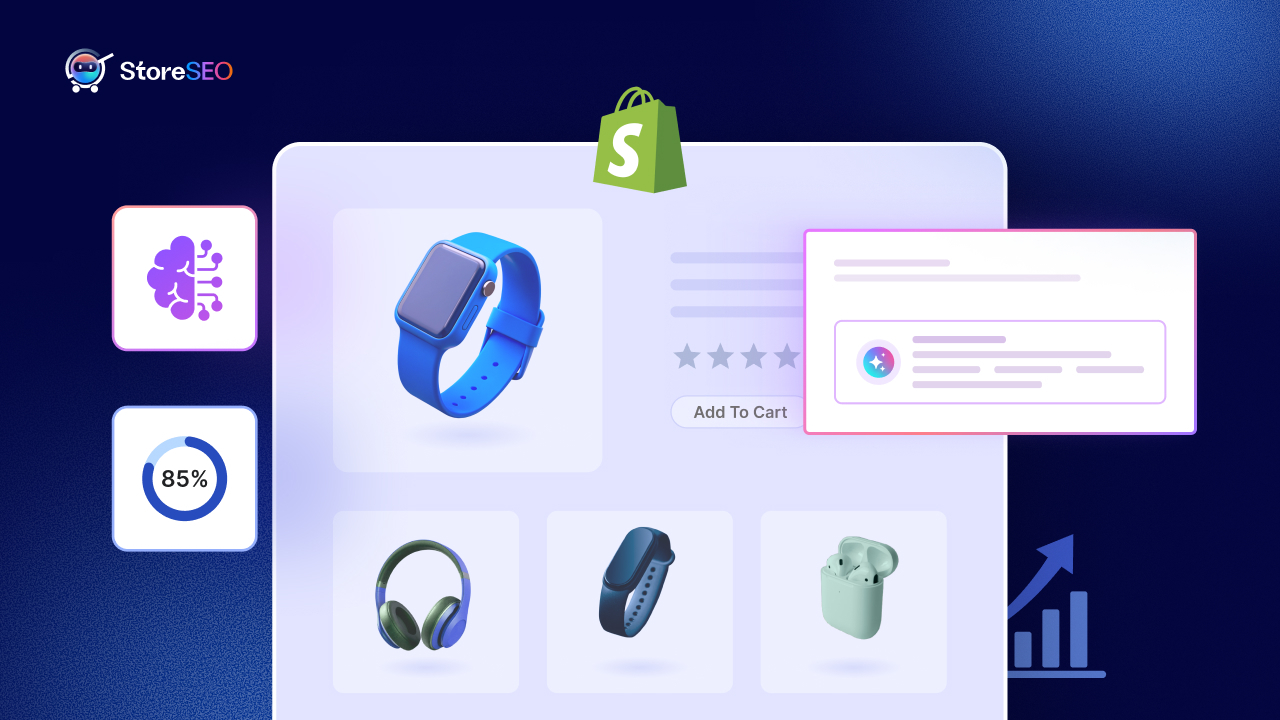Do you know the tips and tricks to make your Shopify store stand out in search engine ranking? One of the basic ways would be using meta tags properly. Using meta tags following the right SEO guidelines helps you rank your pages, products, categories, etc in Shopify. This comprehensive guide will show you how to make your Shopify store more visible on search engines with SEO-friendly meta tags. Curious about how these tweaks can help attract the right customers? Let us find out.

Meta Tags: The Definition And Its Impact on SEO
Meta tags are small pieces of text that tell search engines what your webpage is about. They are not visible on the page itself, but they are important because they help search engines understand your content. Meta tags include things like meta titles and meta descriptions.
However, having well-written meta tags is important for SEO (Search Engine Optimization). They give a quick summary of what your online store is all about, which helps you show up higher in search results when people search for things related to your products.
Now that we know what meta tags are and why they are important, let us talk about the advantages of using correctly used meta tags.
The Advantages of Properly Used Meta Tags
Properly using meta tags helps search engines notice every product, blog post, and collection page on your website. This boosts their visibility online and improves your store’s chances of ranking well in searches, especially for specific topics.
Well-Written Metadata
A well-crafted meta description can be the deciding factor for searchers to visit your store. To nail this, ensure your descriptions are engaging, align with your page content, and feature a clear call-to-action (CTA).
Analyze & Automate SEO Strategy
You can make the most of Shopify’s built-in tools and relevant apps to streamline your SEO efforts, including optimizing meta tags. These resources provide insights and time-saving functionalities to uphold your store’s SEO performance.
A List of Important Meta Tags
Meta tags – the essential elements of HTML that hold important information for a web page in search engines, social media platforms and browsers. From the bunch of meta tags, here we are making a list of meta tags with their purpose.
| Meta Tag | Purpose |
| <title> | Specifies the title of the web page |
| <meta name=”description” content=””> | Provides a brief description of the web page |
| <meta name=”keywords” content=””> | Lists relevant keywords for search engines |
| <meta name=”robots” content=””> | Controls search engine crawling and indexing |
| <meta name=”author” content=””> | Specifies the author of the web page |
| <meta name=”viewport” content=””> | Defines the viewport properties for responsive design |
| <meta http-equiv=”refresh” content=””> | Redirects or refreshes the web page |
| <meta charset=””> | Specifies the character encoding for the HTML document |
| <link rel=”canonical” href=””> | Indicates the preferred version of a web page |
| <meta property=”og:type” content=””> | Specifies the type of content for social sharing |
| <meta property=”og:title” content=””> | Sets the title for social sharing previews |
| <meta property=”og:description” content=””> | Provides a description for social sharing previews |
| <meta property=”og:image” content=””> | Specifies the image for social sharing previews |
| <meta name=”twitter:card” content=””> | Defines the type of card for Twitter sharing |
| <meta name=”twitter:title” content=””> | Sets the title for Twitter sharing previews |
| <meta name=”twitter:description” content=””> | Provides a description for Twitter sharing previews |
| <meta name=”twitter:image” content=””> | Specifies the image for Twitter sharing previews |
Each meta tag mentioned above holds a unique value, but the title and meta description are crucial for optimizing SERPs. The title appears first on the search results page, followed by the meta description, which summarizes the web page’s content for users and search engine crawlers.
Let us have a look at how meta titles and descriptions appear in search engines.

Since you already know, what is meta tags with all their important types along with their advantages; let us move on to how you can create SEO-friendly meta tags for your Shopify store.
Create SEO-friendly Meta Tags for Shopify Stores: Simple Steps to Follow
To create SEO-friendly meta tags for your Shopify store: whether it could be for individual products or blog posts; StoreSEO would be your solution. What is StoreSEO?

StoreSEO is an all-in-one complete Shopify SEO solution to help you make your eCommerce business rank higher on search result pages and attract more potential customers. In simple terms, this is a quick and easy SEO solution for your Shopify store.
However, using StoreSEO you can create SEO-friendly meta tags too for your individual products and blog posts.
How to Create SEO-friendly Meta Tags for Individual Products in Shopify
Using StoreSEO on your Shopify store, you can easily create meta tags for each of your products. All you need to do is, install StoreSEO on your Shopify store & click on ‘Apps’ from the left menu once you’re in. Now navigate to ‘StoreSEO’ → ‘Optimize SEO’ & you will get the entire list of your products.
Once you are on the below-resulting page, click on the ‘Fix issues’ from the right for individual products to create SEO-friendly meta tags.

Now, put your Focus keyword of the product & Meta Title in their respective field. After that, click on Generate from the right to get help from AI Content Optimizer while creating SEO-friendly meta tags. If you want to keep the result or you want to ‘Re-Generate’, it is totally up to you.

How to Create SEO-friendly Meta Tags for Blog Posts in Shopify
Not only just for individual products, but you can also create meta tags for your blog posts in Shopify using StoreSEO. To do so, you need to navigate to StoreSEO → Optimize SEO, and click on the ‘Blog Posts’ section. Under the section, you will get all the blog posts of your Shopify store.

By clicking on ‘Fix issues’ for each blog post, you can create and add SEO-friendly meta tags in each of your blog posts.

Bonus: Add Meta Descriptions, Meta Title & More Using StoreSEO
StoreSEO assists you in enhancing the SEO of your Shopify products by enabling you to input meta titles, descriptions, & focus keywords individually. By accessing your Shopify products to address SEO concerns, you gain access to dedicated sections for adding meta titles, descriptions, keywords, and tags, thereby optimizing each product for search engines. This optimization enhances your search engine ranking and boosts visibility to potential customers.

Ensure that you select a single focus keyword and include up to five tags for each product in your store. This ensures that when your store is live, customers can effortlessly find your products by searching for the focus keywords or related tags.
Once you have addressed all the SEO concerns for each product, achieving a score of 100 indicates that you have thoroughly optimized your Shopify store’s product SEO.

Enhance Your Shopify Store SEO-Friendly with StoreSEO NOW
StoreSEO offers a bunch of exclusive features designed to optimize your Shopify product’s SEO. It streamlines the process by identifying and addressing detailed SEO issues, including meta tags, automatically or manually, ensuring your products rank prominently on search engines. We hope you find this blog insightful to elevate your Shopify store’s SEO performance.
Feel free to share your feedback in the comments section and share it with your friends. Subscribe to our blog for more updates.









